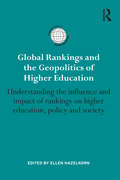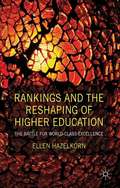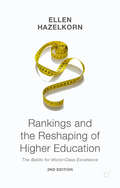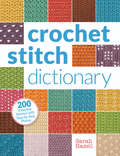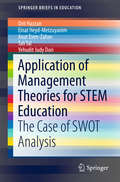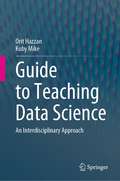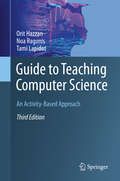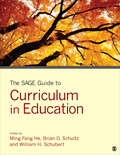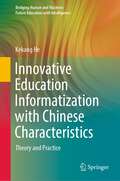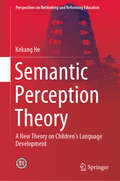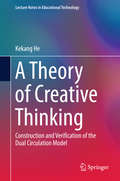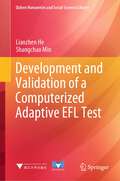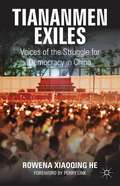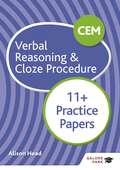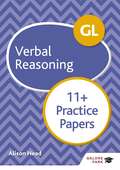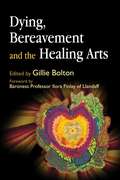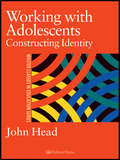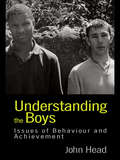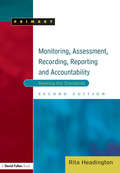- Table View
- List View
Global Rankings and the Geopolitics of Higher Education: Understanding the influence and impact of rankings on higher education, policy and society (International Studies in Higher Education)
by Ellen HazelkornGlobal rankings and the Geopolitics of Higher Education is an examination of the impact and influence that university rankings have had on higher education, policy and public opinion in recent years. Bringing together some of the most informed authorities on this very complex issue, this edited collection of specially commissioned chapters examines the changes affecting higher education and the implications for society and the economy. Split into four interrelated sections, this book covers: The development of rankings in higher education, how they have impacted upon both the production of knowledge and its geography, and their influence in shaping policymaking. Overviews of the significance of rankings for higher education systems in Europe, Asia, Africa, Russia, South America, India and North America. An analysis of rankings in relation to key concerns that pervade contemporary higher education. Examination of the role rankings are likely to play in the future directions for higher education. This is a significant scholarly work that analyses in depth an important development in higher education systems, and which is likely to have an important influence upon how we understand the higher education policy-making process – past, present and future. It provides new analysis and conceptual understanding for researchers, and firm evidence for policy makers to use when addressing the value of rankings in measuring the quality of their institutions. Besides bringing together a powerful cast of academics, this book incorporates contributions from heads of important international higher education organisations – from both those involved in making and also in administering key decisions. This timely, reflective and accessible book forms crucial reading for those studying the subject of rankings, as well as the broader implications and unintended consequences of rankings on national higher education policies. Extending beyond academic researchers and students, this book will also be of significant interest to policymakers, higher education leaders and key stakeholders.
Rankings and the Reshaping of Higher Education
by Ellen HazelkornTen years have passed sincethe first global ranking of universities was published. Since then, universityrankings have continued to attract the attention of policymakers and theacademy, challenging perceived wisdom about the status and reputation, as wellas quality and performance, of higher education institutions. Their impact andinfluence has impacted and influenced policymakers, students and parents,employers and other stakeholders - in addition to higher education institutionsaround the world. They are now a significant factor shaping institutionalambition and reputation, and national priorities. The second edition of Rankings and the Reshaping of HigherEducation, now in paperback, brings the story of rankings up-to-date. It contains new originalresearch, and extensive analysis of the rankings phenomenon. Ellen Hazelkorndraws together a wealth of international experience to chronicle how rankingsare helping reshape higher education in the age of globalization. Written in aneasy but authoritative style, this book makes an important contribution to ourunderstanding of rankings and global changes in higher education. It is essentialreading for policymakers, institutional leaders, managers, advisors, andscholars.
Rankings and the Reshaping of Higher Education
by Ellen HazelkornTen years have passed sincethe first global ranking of universities was published. Since then, universityrankings have continued to attract the attention of policymakers and theacademy, challenging perceived wisdom about the status and reputation, as wellas quality and performance, of higher education institutions. Their impact andinfluence has impacted and influenced policymakers, students and parents,employers and other stakeholders - in addition to higher education institutionsaround the world. They are now a significant factor shaping institutionalambition and reputation, and national priorities. The second edition of Rankings and the Reshaping of HigherEducation, now in paperback, brings the story of rankings up-to-date. It contains new originalresearch, and extensive analysis of the rankings phenomenon. Ellen Hazelkorndraws together a wealth of international experience to chronicle how rankingsare helping reshape higher education in the age of globalization. Written in aneasy but authoritative style, this book makes an important contribution to ourunderstanding of rankings and global changes in higher education. It is essentialreading for policymakers, institutional leaders, managers, advisors, andscholars.
Crochet Stitch Dictionary: 200 Essential Stitches with Step-by-Step Photos
by Sarah HazellA great gift for new and experienced crocheters alike, Crochet Stitch Dictionary offers 200 stitches with detailed written, charted, and photographed instructions. With colorful and eye-catching "candy-box" sampler pages that start every section, this essential book presents hundreds of stitches organized in 10 color-coded sections: - Basic stitches- Fans & Shells- Bobbles & Clusters- Spike stitches- Post stitches- Mesh & Filet- Cable stitches- Tunisian stitches, and more!Each stitch pattern shows a large finished swatch in actual size, along with step-by-step photo instructions that clearly explain where the yarn goes each step of the way. Crochet Stitch Dictionary offers excellent useful instruction and inspiration for all crocheters.
Business Models for Teams: See How Your Organization Really Works and How Each Person Fits In
by Bruce Hazen Tim Clark Yves PigneurAre you frustrated by...• Explaining and re-explaining what people on your team should do?• Solving problems that others should be able to solve for themselves?• Supervising and micromanaging, rather than strategizing and leading?Business Models for Teams will help you overcome these problems. It applies the same simple visual tools that made Business Model Generation and Business Model You so popular and successful around the world. In fact, this book may be the last teamwork toolkit you will ever need!Most leaders over-rely on verbal and written communications. But that approach is outmoded in today’s systems-driven world. Instead, the Business Model Canvas visually depicts how your team really works and how each person fits into the overall mission. It enables people to recognize what needs doing at any given moment—without being asked.
Application of Management Theories for STEM Education: The Case of SWOT Analysis (SpringerBriefs in Education)
by Orit Hazzan Einat Heyd-Metzuyanim Yehudit Judy Dori Anat Even-Zahav Tali TalThis work describes the application of management theories in STEM (Science, Technology, Engineering and Mathematics) education systems. Two chapters examine STEM education on the K-12 national level and one chapter focuses on the higher education institutional level. All chapters are based on comprehensive research. Thus, it will appeal to teachers, school principals, researchers, graduate students, government policymakers, and all practitioners who care about STEM education in schools, academia and government. In each chapter, SWOT (Strengths, Weaknesses, Opportunities, and Threats) analysis is used as a managerial strategic tool for the examination of factors that focus either on internal circumstances (strengths and weaknesses), or external ones (opportunities and threats).
Guide to Teaching Data Science: An Interdisciplinary Approach
by Orit Hazzan Koby MikeData science is a new field that touches on almost every domain of our lives, and thus it is taught in a variety of environments. Accordingly, the book is suitable for teachers and lecturers in all educational frameworks: K-12, academia and industry.This book aims at closing a significant gap in the literature on the pedagogy of data science. While there are many articles and white papers dealing with the curriculum of data science (i.e., what to teach?), the pedagogical aspect of the field (i.e., how to teach?) is almost neglected. At the same time, the importance of the pedagogical aspects of data science increases as more and more programs are currently open to a variety of people.This book provides a variety of pedagogical discussions and specific teaching methods and frameworks, as well as includes exercises, and guidelines related to many data science concepts (e.g., data thinking and the data science workflow), main machine learning algorithms and concepts (e.g., KNN, SVM, Neural Networks, performance metrics, confusion matrix, and biases) and data science professional topics (e.g., ethics, skills and research approach).Professor Orit Hazzan is a faculty member at the Technion’s Department of Education in Science and Technology since October 2000. Her research focuses on computer science, software engineering and data science education. Within this framework, she studies the cognitive and social processes on the individual, the team and the organization levels, in all kinds of organizations.Dr. Koby Mike is a Ph.D. graduate from the Technion's Department of Education in Science and Technology under the supervision of Professor Orit Hazzan. He continued his post-doc research on data science education at the Bar-Ilan University, and obtained a B.Sc. and an M.Sc. in Electrical Engineering from Tel Aviv University.
Guide to Teaching Computer Science: An Activity-Based Approach
by Orit Hazzan Noa Ragonis Tami LapidotThis concise yet thorough textbook presents an active-learning model for the teaching of computer science. Offering both a conceptual framework and detailed implementation guidelines, the work is designed to support a Methods of Teaching Computer Science (MTCS) course, but may be applied to the teaching of any area of computer science at any level, from elementary school to university. This text is not limited to any specific curriculum or programming language, but instead suggests various options for lesson and syllabus organization.Fully updated and revised, the third edition features more than 40 new activities, bringing the total to more than 150, together with new chapters on computational thinking, data science, and soft concepts and soft skills. This edition also introduces new conceptual frameworks for teaching such as the MERge model, and new formats for the professional development of computer science educators.Topics and features: includes an extensive set of activities, to further support the pedagogical principles outlined in each chapter; discusses educational approaches to computational thinking, how to address soft concepts and skills in a MTCS course, and the pedagogy of data science (NEW); focuses on teaching methods, lab-based teaching, and research in computer science education, as well as on problem-solving strategies; examines how to recognize and address learners’ misconceptions, and the different types of questions teachers can use to vary their teaching methods; provides coverage of assessment, teaching planning, and designing a MTCS course; reviews high school teacher preparation programs, and how prospective teachers can gain experience in teaching computer science.This easy-to-follow textbook and teaching guide will prove invaluable to computer science educators within all frameworks, including university instructors and high school teachers, as well as to instructors of computer science teacher preparation programs.
The SAGE Guide to Curriculum in Education
by Dr Ming Fang He Dr Brian D. Schultz Dr William H. SchubertThe SAGE Guide to Curriculum in Education integrates, summarizes, and explains, in highly accessible form, foundational knowledge and information about the field of curriculum with brief, simply written overviews for people outside of or new to the field of education. This Guide supports study, research, and instruction, with content that permits quick access to basic information, accompanied by references to more in-depth presentations in other published sources. This Guide lies between the sophistication of a handbook and the brevity of an encyclopedia. It addresses the ties between and controversies over public debate, policy making, university scholarship, and school practice. While tracing complex traditions, trajectories, and evolutions of curriculum scholarship, the Guide illuminates how curriculum ideas, issues, perspectives, and possibilities can be translated into public debate, school practice, policy making, and life of the general public focusing on the aims of education for a better human condition. 55 topical chapters are organized into four parts: Subject Matter as Curriculum, Teachers as Curriculum, Students as Curriculum, and Milieu as Curriculum based upon the conceptualization of curriculum commonplaces by Joseph J. Schwab: subject matter, teachers, learners, and milieu. The Guide highlights and explicates how the four commonplaces are interdependent and interconnected in the decision-making processes that involve local and state school boards and government agencies, educational institutions, and curriculum stakeholders at all levels that address the central curriculum questions: What is worthwhile? What is worth knowing, needing, experiencing, doing, being, becoming, overcoming, sharing, contributing, wondering, and imagining? The Guide benefits undergraduate and graduate students, curriculum professors, teachers, teacher educators, parents, educational leaders, policy makers, media writers, public intellectuals, and other educational workers. Key Features: Each chapter inspires readers to understand why the particular topic is a cutting edge curriculum topic; what are the pressing issues and contemporary concerns about the topic; what historical, social, political, economic, geographical, cultural, linguistic, ecological, etc. contexts surrounding the topic area; how the topic, relevant practical and policy ramifications, and contextual embodiment can be understood by theoretical perspectives; and how forms of inquiry and modes of representation or expression in the topic area are crucial to develop understanding for and make impact on practice, policy, context, and theory. Further readings and resources are provided for readers to explore topics in more details.
The SAGE Guide to Curriculum in Education
by Dr Ming Fang He Dr Brian D. Schultz Dr William H. SchubertThe SAGE Guide to Curriculum in Education integrates, summarizes, and explains, in highly accessible form, foundational knowledge and information about the field of curriculum with brief, simply written overviews for people outside of or new to the field of education. This Guide supports study, research, and instruction, with content that permits quick access to basic information, accompanied by references to more in-depth presentations in other published sources. This Guide lies between the sophistication of a handbook and the brevity of an encyclopedia. It addresses the ties between and controversies over public debate, policy making, university scholarship, and school practice. While tracing complex traditions, trajectories, and evolutions of curriculum scholarship, the Guide illuminates how curriculum ideas, issues, perspectives, and possibilities can be translated into public debate, school practice, policy making, and life of the general public focusing on the aims of education for a better human condition. 55 topical chapters are organized into four parts: Subject Matter as Curriculum, Teachers as Curriculum, Students as Curriculum, and Milieu as Curriculum based upon the conceptualization of curriculum commonplaces by Joseph J. Schwab: subject matter, teachers, learners, and milieu. The Guide highlights and explicates how the four commonplaces are interdependent and interconnected in the decision-making processes that involve local and state school boards and government agencies, educational institutions, and curriculum stakeholders at all levels that address the central curriculum questions: What is worthwhile? What is worth knowing, needing, experiencing, doing, being, becoming, overcoming, sharing, contributing, wondering, and imagining? The Guide benefits undergraduate and graduate students, curriculum professors, teachers, teacher educators, parents, educational leaders, policy makers, media writers, public intellectuals, and other educational workers. Key Features: Each chapter inspires readers to understand why the particular topic is a cutting edge curriculum topic; what are the pressing issues and contemporary concerns about the topic; what historical, social, political, economic, geographical, cultural, linguistic, ecological, etc. contexts surrounding the topic area; how the topic, relevant practical and policy ramifications, and contextual embodiment can be understood by theoretical perspectives; and how forms of inquiry and modes of representation or expression in the topic area are crucial to develop understanding for and make impact on practice, policy, context, and theory. Further readings and resources are provided for readers to explore topics in more details.
Innovative Education Informatization with Chinese Characteristics: Theory and Practice (Bridging Human and Machine: Future Education with Intelligence)
by Kekang HeThis book contains the research of Innovative Education Informatization conducted by researchers from School of Educational Technology, Beijing Normal University since early 1990s. There are three main parts of the book. The first part is about six pillars supporting the theory of Innovative Education Informatization with Chinese Characteristics. Six theories are: 1) Theory of Creative Thinking, 2) New Constructivism, 3) Theory of In-depth Integration of Information Technology and Subjects Teaching, 4) New Theory of Teaching Design, 5) Theory of Children’s Thinking Development, and 6) Language Sense Theory. The second part pays attention to advocating maker education system with Chinese characteristics. The third part focuses on Chinese-style flipped classroom. The book will have profound impact on education informatization.
Semantic Perception Theory: A New Theory on Children's Language Development (Perspectives on Rethinking and Reforming Education)
by Kekang HeBased on an in-depth study of children’s language development theory, this book puts forward the original proposition that semantic perception is the human sixth sense. Presenting a detailed, complete, and scientific argumentation, it asserts that the innateness of semantic perception has a physiological basis and that language acquisition is based on semantic perception, and proposes the idea of a critical period of nurture and language growth. To this end, the book not only contrasts children’s language acquisition processes and the process of adult speech generation and comprehension, but also discusses the ability to read and write, describing this important stage of children’s language development and analyzing semantic perception. Focusing on education and psychology, it also discusses the use of semantic perception theory to instruct teaching and learning. This book is a valuable resource for teachers, researchers, practitioners and graduate students in the fields of educational technology, child development and language learning, as well as anyone interested in children’s language development.
A Theory of Creative Thinking: Construction and Verification of the Dual Circulation Model (Lecture Notes in Educational Technology)
by Kekang HeThis book examines research on creative thinking, both current and historical. It explores two dimensions of human thought (time and space) and two modes of thinking (conscious and unconscious) as well as both left and right brain functions and artistic and scientific creative activities. The book proposes a "Double Circulation" model of creative thinking and argues that imagery thinking, intuitive thinking and logical thinking are main parts of creative thinking and that dialectical thinking and horizontal-vertical thinking are the guides for highly complex problem-solving thoughts and strategies. The book focuses on education and psychology and also covers how to use ICT to promote students' creative thinking skills. Researchers will benefit from the "Double Circulation" model, which provides a new perspective on conducting creative thinking research. The book is also a valuable resource for graduate students in the fields of educational technology and psychology and for all readers who are interested in creative thinking.
Development and Validation of a Computerized Adaptive EFL Test (Qizhen Humanities and Social Sciences Library)
by Lianzhen He Shangchao MinThe book reports on the development and validation of a computerized adaptive EFL test, which is used as an exit requirement for non-English-major undergraduates at a major Chinese university. Unlike the tests reported in previous research on computerized adaptive language test (CALT), which were mostly designed to assess vocabulary, grammar and reading, this test consists of listening and reading components using both dichotomously-scored stand-alone items and polytomously-scored testlet-based items. The book is an essential and stimulating read for researchers and graduate students in the testing domain, particularly for those who are interested in CALT, item response theory (IRT), and quantitative research methods in general. It also constitutes a solid reference resource for L2 teachers and test developers. One of the distinctive features of the book is its operationalization of assessment use argument (AUA) in the investigation of the construct validity of the CALT. Another strength of this book is that it provides insight into the specific procedures that are followed in the development of CALTs and addresses a few key issues, such as local item dependence and DIF detection that were ignored in previous CALT development research.
Tiananmen Exiles
by Rowena Xiaoqing HeIn the spring of 1989, millions of citizens across China took to the streets in a nationwide uprising against government corruption and authoritarian rule. What began with widespread hope for political reform ended with the People's Liberation Army firing on unarmed citizens in the capital city of Beijing, and those leaders who survived the crackdown became wanted criminals overnight. Among the witnesses to this unprecedented popular movement was Rowena Xiaoqing He, who would later join former student leaders and other exiles in North America, where she has worked tirelessly for over a decade to keep the memory of the Tiananmen Movement alive. This moving oral history interweaves He's own experiences with the accounts of three student leaders exiled from China. Here, in their own words, they describe their childhoods during Mao's Cultural Revolution, their political activism, the bitter disappointments of 1989, and the profound contradictions and challenges they face as exiles. Variously labeled as heroes, victims, and traitors in the years after Tiananmen, these individuals tell difficult stories of thwarted ideals and disconnection, but that nonetheless embody the hope for a freer China and a more just world.
CEM 11+ Verbal Reasoning & Cloze Procedure Practice Papers
by Alison HeadPractice exam papers to test pupils ahead of the CEM 11+ Verbal Reasoning test, including those taking bespoke tests created by CEM for individual schools. Four levelled papers test pupils' skills in verbal reasoning and cloze procedure.The papers are designed to:-Develop and perfect exam technique for all CEM 11+ tests- Teach pupils to improve their response rates with timed papers- Provide a variety of question formats to suit paper-based and online tests- Identify weaker areas and improve results by studying the answers, which contain references to Galore Park's revision materials for guidance and useful tips- The resource also contains links to downloadable answer sheets so that the tests can be re-sat.These practice papers are part of Galore Park's 11+ revision series, which provides a three-step learning journey that teaches children the skills needed to pass rigorous school entrance exams.
CEM 11+ Verbal Reasoning & Cloze Procedure Practice Papers
by Alison HeadPractice exam papers to test pupils ahead of the CEM 11+ Verbal Reasoning test, including those taking bespoke tests created by CEM for individual schools. Four levelled papers test pupils' skills in verbal reasoning and cloze procedure.The papers are designed to:- Develop and perfect exam technique for all CEM 11+ tests- Teach pupils to improve their response rates with timed papers- Provide a variety of question formats to suit paper-based and online tests- Identify weaker areas and improve results by studying the answers, which contain references to Galore Park's revision materials for guidance and useful tips- The resource also contains links to downloadable answer sheets so that the tests can be re-sat.These practice papers are part of Galore Park's 11+ revision series, which provides a three-step learning journey that teaches children the skills needed to pass rigorous school entrance exams.
GL 11+ Verbal Reasoning Practice Papers
by Alison HeadFour practice exam papers to test pupils ahead of the GL 11+ Verbal Reasoning test, includingthose taking bespoke tests created by GL for individual schools. The papers are designed to:- Develop and perfect exam technique for GL 11+ Verbal Reasoning tests- Teach pupils to improve their response rates with timed papers- Identify weaker areas and improve results by studying the answers, which contain references to Galore Park's revision materials for guidance and useful tips- The resource also contains links to downloadable answer sheets so that the tests can be re-sat.These practice papers are part of Galore Park's 11+ revision series, which provides a three-step learning journey that teaches children the skills needed to pass rigorous school entrance exams.
GL 11+ Verbal Reasoning Practice Papers
by Alison HeadFour practice exam papers to test pupils ahead of the GL 11+ Verbal Reasoning test, includingthose taking bespoke tests created by GL for individual schools. The papers are designed to:- Develop and perfect exam technique for GL 11+ Verbal Reasoning tests- Teach pupils to improve their response rates with timed papers- Identify weaker areas and improve results by studying the answers, which contain references to Galore Park's revision materials for guidance and useful tips- The resource also contains links to downloadable answer sheets so that the tests can be re-sat.These practice papers are part of Galore Park's 11+ revision series, which provides a three-step learning journey that teaches children the skills needed to pass rigorous school entrance exams.
Dying, Bereavement and the Healing Arts
by David Head John Graham-Pole Diana Greenman Sandra Bertman Kaichiro Tamba Mark Cobb Tim Jeeves Ted Bowman Sheelagh Gallagher River Wolton Rogan Wolf Giles Legood Chris Rawlence Tim Metcalf Yvonne Yi-Wood Mak Haifa Al Sanousi Paul Schatzberger Corine Koppenol Robert Hamberger Kate D'Lima Amy Kuebelbeck Oliver Samuel Julie Sanders Gillie Bolton Frans Meulenberg Monica Suswin Sue Eckstein Nigel Hartley Sinead Donnelly Judy Clinton Kieran Walsh Filipa Pereira-Stubbs Anna Lidzey Mike White Bobbie Farsides Steve Seagull Christopher Johns Christina Mason Ashley Barnes Mitzi Blennerhassett Lesley Schatzberger Lindsay Buckell Hilary ElfickDying, Bereavement and the Healing Arts describes a range of successful programmes pioneered by artists, writers, nurses, musicians, therapists, social workers, and chaplains in palliative care settings. These range from simple painting and writing activities to organized communal activities like writing and performing a play. The arts are shown to offer a means to reflect on memories, hopes, fears and anxieties, and gently explore the emotional, spiritual, and psychological issues which can aid a fuller understanding of oneself and one's condition. The arts also serve as a way to communicate difficult and complex feelings to professionals or family members not possible in everyday conversation. Dying, Bereavement and the Healing Arts offers valuable insights and inspiration for any practitioner working in a palliative care setting.
Working With Adolescents: Constructing identity
by Dr John Head John HeadThis work examines the way in which personality and identity of the pupil is shaped by his or her experiences in school. The text considers the way in which teachers in secondary schools are working, and to some extent living, with adolescent pupils for the majority of time in their weekday waking lives. The book examines: to what extent teachers provide both positive and negative role models for pupils to follow; the factors restricting the ability of teachers to teach effectively; and conversely, what factors work to their advantage.; The text provides an overview of the debates and research into areas of: teaching children about controversial subjects such as sex and drugs; gender differences; identities; peer groups; relations with adults; and beliefs and values.
Understanding the Boys: Issues of Behaviour and Achievement
by John Head Dr John HeadDo you know what makes boys tick? In recent years suicide has drastically escalated among young males and academic underachievement is common, so it is of vital importance that our understanding of the young male psyche is well informed and not merely 'received wisdom'. John Head gets to the heart - and mind - of the matter, by tackling difficult, pertinent questions. Has male behaviour in school worsened, or has media hype inflated the proportions of a 'good story'? What is at the root of male violence? Are biological or social explanations telling the whole story? Head shows that it is only by engaging boys in new arenas of thought and feeling that we can hope to understand and help overcome the difficulties faced by boys today.Essential reading for teachers, headteachers, researchers in education, gender, youth, community and social workers.
I Can Run (I Like to Read)
by Murray HeadA squirrel’s antics and entertaining photographs enliven a book for the newest reader at Guided Reading Level A. I can run. I can hop. I can jump. A simple text for the newest readers and fascinating photographs follow a captivating squirrel as he runs just for fun—and also to escape a scary hawk.
Monitoring, Assessment, Recording, Reporting and Accountability, Second Edition: Meeting the Standards
by Rita HeadingtonThis comprehensive, practical second edition has been updated in line with the new standards for qualified teacher status, in particular the competence in monitoring and assessment. Writing primarily for student and newly qualified teachers, whose classroom experience is necessarily limited, the author takes pains to elucidate why to assess, what to assess and how to assess. Theory and practice are linked throughout by way of case studies, activities and discussion points. Question and answer format, children's work and authentic written records are used to exemplify monitoring and assessment in action as part of the planning cycle. Photocopiable examples of recording sheets and a glossary of terms provide readers with valuable starting points for their own practice.
